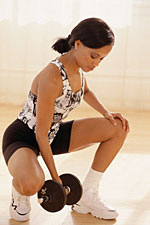
Why weight loss requires strength training, even in women and seniors
 Saturday, August 27, 2005 Saturday, August 27, 2005by Mike Adams, the Health Ranger Editor of NaturalNews.com (See all articles...) Tags: weight loss, strength training, physical exercise |
- Biblical truth: God will carry out a “cosmic reset” of Earth and destroy all human civilization with a series of extinction-level cosmic impacts known as The Seven Trumpets, Seven Bowls and Seven Seals
- Scientists debate possibility of TIME TRAVEL, after Trump Admin says new technologies can "bend space and time"
- U.S. closes controversial State Department office accused of pushing political censorship under Biden
- Russia escalates censorship war, targets over 200 VPN apps amid Google resistance
- Aerosolized bioweapons? Strange “diploid biomasses” falling out of the sky in Florida captured under the microscope
- U.S. demands U.K. protect FREE SPEECH, repeal hate speech authoritarianism, in latest trade deal negotiations
- Eat your MEAT! Study finds children need to eat more animal protein for survival and development
- Trump administration halts major offshore wind project amid fears of “rushed” approvals and environmental compromises
- STUDY: Half of vegans at risk of muscle loss due to nutrient deficiencies
- New York proposes blockchain integration in public payments
- Kiss Your Genetic Privacy Good-Bye! 23andMe Gets Green Light to Sell Your Intimate Genetic Details to Anyone They Want
- “Wartime Homefront Essential Skills” on BrightU: Experts discuss foraging and 12 medicinal herbs to grow in your backyard
- Analysis: The coming economic collapse, a mass uprising and Trump's three secret weapons to halt the growing revolt
- Unlocking the role of amino acids in Autism Spectrum Disorder (ASD): A review of the evidence
- Widespread social and economic unrest: Steve Quayle issues urgent financial warning of imminent asset collapse in new interview with Mike Adams
- Trump signs memorandum that seeks to prevent illegals from improperly accessing benefits
- Possible biosignatures detected on Exoplanet K2-18b, raising hopes for alien life
- Trump administration proposes over $40 billion budget cut for federal health agencies
- Aerosolized bioweapons? Strange “diploid biomasses” falling out of the sky in Florida captured under the microscope
- Analysis: The coming economic collapse, a mass uprising and Trump's three secret weapons to halt the growing revolt
- Widespread social and economic unrest: Steve Quayle issues urgent financial warning of imminent asset collapse in new interview with Mike Adams
- Israeli lobbyists boast of controlling US national security policy in leaked AIPAC audio
- Kiss Your Genetic Privacy Good-Bye! 23andMe Gets Green Light to Sell Your Intimate Genetic Details to Anyone They Want
- TAKE IT DOWN Act advances in Congress amid free speech concerns
- Mike Adams releases country western hit single: Goin’ Back in Time is Comin’ Home
- Russia escalates censorship war, targets over 200 VPN apps amid Google resistance
- U.S. lawmakers investigate Meta over alleged China collaboration
- CLOT SHOT PLANDEMIC UNFOLDING: Fibrous, rubbery clots caused by covid injections have prion-like seeding activity
- Warp Speed 2.0: Trump Administration ACCELERATES Gates-funded, self-amplifying bird flu vaccines
- Defunding DEADLY mRNA jabs: Government funding for mRNA technology being scrutinized and sidelined until proven "safe and effective" for real
- Curcumin’s ancient healing power supercharges muscle recovery, and its effects are compounded with anti-inflammatory foods and supplements
- I Want My Bailout Money – new song and music video released by Mike Adams
- Fauci is back in the limelight, and he’s busy promoting a future COVID or FLU pandemic
- I Want My Bailout Money – new song released by Mike Adams
- Trump administration poised to overhaul crypto regulations with new SEC leadership
- Federal employees whine over DOGE's new directive requiring them to do a 5-point summary of weekly accomplishments
- Newly released JFK files reveal Pentagon's role in creating Lyme disease and covid in the same lab
- Analysis: The coming economic collapse, a mass uprising and Trump's three secret weapons to halt the growing revolt
- Aerosolized bioweapons? Strange “diploid biomasses” falling out of the sky in Florida captured under the microscope
- Kiss Your Genetic Privacy Good-Bye! 23andMe Gets Green Light to Sell Your Intimate Genetic Details to Anyone They Want
- Mike Adams releases country western hit single: Goin’ Back in Time is Comin’ Home
- European Court of Justice: Healthcare professionals who promoted or administered COVID-19 vaccines are CRIMINALLY LIABLE for any harm caused
- Widespread social and economic unrest: Steve Quayle issues urgent financial warning of imminent asset collapse in new interview with Mike Adams
- Federal employees whine over DOGE's new directive requiring them to do a 5-point summary of weekly accomplishments
- CLOT SHOT PLANDEMIC UNFOLDING: Fibrous, rubbery clots caused by covid injections have prion-like seeding activity
- U.S. approves new Russian ambassador as diplomatic thaw continues
- I Want My Bailout Money – new song and music video released by Mike Adams
- I Want My Bailout Money – new song released by Mike Adams
- Government waste exposed: Hegseth supports Musk’s demand for accountability from federal workers
- Trump administration poised to overhaul crypto regulations with new SEC leadership
- Defunding DEADLY mRNA jabs: Government funding for mRNA technology being scrutinized and sidelined until proven "safe and effective" for real
- Fauci is back in the limelight, and he’s busy promoting a future COVID or FLU pandemic
- South Carolina Congressman proposes new $250 bill and wants Trump on the front
- Now you can HEAR chemistry: Health Ranger translates molecules into music in stunning video demonstration that will blow your mind (and your ears)
- Red Cross issues warning to stop blood plasma donations from vaccinated people
- Scientists confirm: GENIUS brain function can be spontaneously unleashed in humans without any apparent cause
- EPA advisor admits the agency is funneling billions to climate groups ahead of Trump’s return to White House
- HYSSOP: What research reveals about the health benefits of this ancient holy herb
- Two containers with completed ballots fall out of truck in Florida
- Mike Adams releases country western hit single: Goin’ Back in Time is Comin’ Home
- Newly released JFK files reveal Pentagon's role in creating Lyme disease and covid in the same lab
- Global leaders unite to clamp down on “misinformation” with UN-backed Cascais Declaration
- BREAKING: 2025 NDAA authorizes mandatory military draft of WOMEN across America… as Pentagon pursues global NUCLEAR war with both Russia and China at the same time
- I Want My Bailout Money – new song released by Mike Adams
- Michael Yon warns of a ZIONIST TAKEOVER in Trump’s second administration
- The Health Ranger releases “Vaccine Zombie” song and music video, using AI-animated zombies for the music video
- Ozempic and Wegovy weight loss drugs are injectable LIZARD VENOM PEPTIDES that may unleash a devastating wave of organ failure… side effects align with symptoms of SNAKE BITES
- BOMBSHELL: DNA testing kits are a SCAM to develop ethnic-specific bioweapons
- Israeli soldiers accused of even more torture and abuse in the West Bank
- These 13 countries just signed an agreement to engineer a global FAMINE by destroying food supply
- RFK Jr. clears key hurdle: Sen. Susan Collins backs controversial HHS nominee, signaling a new era for health policy
- NASA admits that climate change occurs because of changes in Earth’s solar orbit, and NOT because of SUVs and fossil fuels
Why is strength training important for losing weight? Because a lot of people try to starve themselves into weight loss. They think it's all about controlling calories. Unfortunately, a lot of dieticians and nutritionists don't really understand strength training, and they also think that it's just about calories. Calories in, calories out. If you have a calorie deficit, you're going to lose weight, if you consume extra calories, you'll gain body fat. While that's true, it's only part of the picture. Sure, you need a calorie deficit to lose weight, but how does your body actually use calories? It's your lean body mass, that muscle mass underneath your body fat, that burns calories 24/7, allowing you to actually eat more calories without gaining weight.
Let's say you happen to be quite obese and you have a high percentage of body fat. I used to be in that situation; I know what it feels like. Underneath that body fat you actually have a very strong skeleton and strong muscles. Your body has built up those muscles in order to carry all of that extra body fat when you move your body. Just the very act of standing up, walking across a parking lot, going up a flight of stairs or lifting your arms requires more effort when you're overweight, especially if you're obese. So the heavier you are, the stronger your muscles have to be just to allow you to do basic, everyday things.
Now this can actually work to your advantage -- if you manage to keep all of that muscle mass and bone density in place while you are losing body fat, then you can maintain the high metabolism that's associated with that lean body mass even while you are dropping body fat. But if you starve yourself, you're going to lose all the muscle resources you already have. It's a mistake a lot of people make. They try to lose body fat by starving themselves, and as the body fat vanishes from their body, their muscle mass also disappears. Why would the body get rid of muscle mass? Because, frankly, it doesn't need it.
Your body adapts to the need
You see, the body is an adaptive system. It will adapt to whatever loads you place on it. So if you are a heavier person and you're carrying around body fat, then your body will adapt by creating stronger muscles to lift your body. It's almost like doing a leg press every time you get up out of the chair. If you weigh 300 lbs you're doing a 300 lb leg press, you see? Now if you were to drop 150 lbs of body fat and end up at 150 lbs, your body wouldn't need the same amount of leg muscle to lift you. It would eliminate those leg muscles through catabolic action.While it eliminates this muscle mass, your metabolism begins to slow. Remember, it's the lean body mass that's burning calories day in and day out, even when you're doing nothing. If you reduce that muscle mass by allowing it to go away (by not challenging your muscles), then your metabolism is going to slow. A lot of people end up at a place where they've lost the body fat and they're lighter, but it's suddenly so much easier to put on body fat. They don't have the muscle mass they once did, they're not automatically burning calories, and if they overeat just a little bit, they'll start packing on the body fat again.
Strength train while losing weight
The solution to all of this, the strategy I want to focus on here, is to engage in strength training while you are losing body fat. If you do this, then you will be able to maintain the muscle mass that you already have underneath your body fat while you are in the process of losing the fat. This will leave you with a greater proportion of lean body mass to body fat, meaning that you will be slimmer, yet you'll have the muscles that you had when you were overweight.If you get rid of enough body fat in this way, then those muscles may begin to show -- if you're a man. If you're a woman, don't worry. You're never going to bulk up. A lot of women are mistakenly afraid of strength training. They think that if they pump a few weights they're going to turn into Lou Ferrigno overnight. They think they're going to have this competition muscle-bound body from lifting a couple of weights. Believe me, that is not the case at all. Most of those bodybuilding women are using steroids, and they've trained for years, even decades, just to produce that kind of muscle mass. Women are not built to puts on lots of muscle mass, so don't be afraid that you'll bulk up. Women who are afraid of exercising because they think it's going to make them look bigger have it all wrong.
Women need strength training, too
Let's take a moment to cover that myth here. Let's say you're a woman and you have more body fat than you want. You're trying to decide, "Should I engage in strength training as part of my weight loss program?" Some women say, "No, because I'll bulk up and it'll make me look fatter." That's a complete myth; it's totally false.When you have a high percentage of body fat, that body fat is stored not only in the tissues that are obvious -- such as your hips and your midsection, your arms and legs and so on -- it's also stored intramuscularly, which means it's stored within the muscles of your body. It's sort of like the marbling of beef from a cow. If you slice a muscle from a cow, there's some fat inside the muscle -- that is the same kind of fat that's in our muscles when we have a high percentage of body fat.
That fat takes up a lot of space in the muscle, so it actually makes the muscle look bigger, because there's fat inside. When you start losing body fat, even if you're engaged in strength training, that intramuscular fat will begin to vanish. So even if your muscle mass begins to grow -- which, again, is very difficult for women to accomplish -- your overall muscle size is probably going to be smaller when you're at a lower percentage of body fat. The net change in your muscle size is going to be almost nothing, unless you really start to do strength training on a regular basis for a period of a year or two, and then you might actually begin to put on a little bit more muscle.
Don't lose the muscle you've already built
So with that crazy myth covered, let's get back to the main point here, which is that engaging in strength training will conserve the muscle mass you have now. Now here's why this is so important. It's very easy for your body to shed useless muscle. So if you're not using a muscle, your body will get rid of it over a few months. It's gone. But to gain that muscle back -- now that takes some effort! That could take months or years of strength training. It is much harder for your body to engage in anabolic reactions (to build muscle mass) than it is for your body to catabolize and get rid of muscles. So, if you decide you're going to starve yourself while you lose weight and get down to the minimum weight possible, and afterwards you engage in strength training, then you're going to find that it's a much more difficult process to gain lean body mass than it was to slim away what you had to begin with. Building lean body mass is a huge challenge.It's also important to note that when people talk about weight loss, they throw that term around without really understanding what it means. Everybody says "I want to lose weight," but they don't really mean that. They mean they want to lose body fat; they don't want to just lose weight. A limb amputation will cause you to lose weight, but that's not what people have in mind! People want to lose body fat. So be careful what you wish for -- and don't use that bathroom scale as a measure of your progress. There are a number of reasons why.
One is if you just starve yourself and you start losing lean body mass, then that counts as weight loss. But you've done yourself no good whatsoever, because now you've actually lowered your metabolism. The scale says, "Hey! You lost another three pounds!" But it could be 2 lbs of fat and 1 lb of muscle, and that's not a good situation to be in. You want to lose maybe 2.9 lbs of fat and 0.1 lbs of muscle, or maybe 3 lbs of fat and no muscle. But to do that, you've got to challenge your muscular system through some weight bearing exercise.
Don't forget the glycogen fuel stored in your body
The other thing to keep in mind when you're using the bathroom scale is that when you first start limiting your calories, your body is going to start burning through its glycogen stores. Glycogen is basically a fuel stored in your body. It stores sugars together with water and locks them up in the tissues and organs of your body like an energy battery, ready for you to use at a future time.There's water locked in with those calories. That water weighs a lot. So when you start restricting your calories, the first thing your body burns is this extra storage of energy, this extra glycogen. And the glycogen causes you, as it's burned, to shed water. You might look at the scale and think, gee, I lost 5 lbs, but you really lost no body fat whatsoever. It was just water, because your body released glycogen. What usually happens to people when their glycogen store has reached zero is they get really hungry, they think they're in a starvation panic, and then they overeat. Their glycogen stores fill right back up, they gain the 5 lbs back, and usually they overate to such an extent that they store another half a pound of body fat or so. Now they're half a pound heavier than when they began and they lost no body fat whatsoever. It was just a game of glycogen and water storage they saw reflected on the bathroom scale.
Bathroom scales are useless
So ignore the bathroom scale. It is not useful for telling you how successful you are in losing body fat. I don't use one at all. The only measure you should use is a "fat scale" or a caliper. A caliper is the best way to measure body fat. Body fat calipers measure the thickness of body fat in key locations around your body. For men, one location is on the upper pectoral area, another is the midsection and the third is on the top of the quadriceps of the leg. For women it's the back of the arm, the midsection and along the hip.However, you've got to learn how to use a caliper correctly if you want it to be an accurate indicator of fat loss success. I just mention it as a tool for people who are really serious about losing fat. People who use bathroom scales to figure out how much weight they've lost are just playing a silly game of deception -- the bathroom scale is useless. I mean, you could lose bone mass and you'd still look like you were having lots of progress on the bathroom scale.
How do you lose bone mass? Easy: you stop engaging in exercise, stop walking, stop running. If you do all that (which I'm not recommending, by the way), then you would start to lose bone mineral density, and that would be reflected as weight loss. When you say you want to lose weight, be careful what you ask for. Your body has a number of ways to lose weight that have nothing whatsoever to do with losing body fat or enhancing your overall state of health.
Engage in weight training when losing body fat
Now let's get back to the main point, strength training and why it is so important. So far, I hope I've explained the idea that underneath your body fat you have a strong musculoskeletal system. There's a lot of muscle mass and good, strong bones underneath all of that body fat. If you find a strategy to conserve that, even while you're losing body fat, then you can have a much more successful weight loss experience and end up with a strong skeleton and strong muscles at the end of your regimen as well.The way to do that is to engage in basic weight-bearing strength training while you are pursuing a diet. And it turns out that you don't have to go crazy on this. I am not suggesting that you go to the gym and start pumping iron on the bench press, 50 reps a day, or that you exhaust your body with crazy workouts. It turns out that you don't even need to stress your body very much to maintain the current muscle mass that you have.
15 seconds of stress creates new muscle
In fact, there's a system of strength training called static contraction training that is outstanding for maintaining current muscle mass and even enhancing it if you choose to go that far. The best thing is that it takes very little time. How much time am I talking about? You'll be amazed to hear this, but literally, it's true: 15 seconds per muscle group per week. Only 15 seconds per muscle. If you engage that muscle for 15 seconds with high intensity contraction, then your body gets the signal that, hey, it needs that muscle. It needs to keep it around. And your body decides NOT to let that muscle go. It just keeps it, because it figures you need it.Remember, your body has a lot of wisdom, and it's trying to conserve calories. The body wants to get rid of muscles it doesn't need, and in order to keep those muscles, you have to prove to your body that you need them. Now the thing is, your body doesn't know why you need them. It could be that you're engaged in some kind of competition, it could be that you need to lift heavy things to survive. Your body doesn't really know the reason why. You can essentially fool your body by engaging in strength training, giving it the message that it needs to hold on to those muscles in order to survive. So in as little as 15 seconds per muscle group, you can tell your body to hold on to your muscle mass. That's a 15 second bicep curl, for example, or a 15 second chest press, or a 15 second leg curl…you get the idea.
To learn more on this, I suggest you get a book called Power Factor Training by John Little and Pete Sisco. Check out that book. It gives you the lowdown on how to do this. It's positioned at bodybuilders, but it's actually the underground secret book of strength training for people who are 50 years and older. Senior citizens benefit from this tremendously. There are also many golfers who use this system to greatly increase their range and golf swing.
Women are additionally benefiting from this system -- when you're dealing with the potential for osteoporosis when you get up in your years, bone density becomes crucial for your overall health. There is no better way in the world to make sure you have strong bone density than to engage in high intensity, short duration strength training exercises. Static contraction training is, in my view, the very best system of exercise for maintaining not just muscle mass, but also bone mineral density. You will also strengthen your ligaments and tendons.
The key is, as with all forms of exercise, to be sure to work with a qualified health professional before attempting this, especially some of the more high intensity exercises. You may want to ease your way into it and check with your naturopath, doctor or physical therapist to make sure you're ready for this. You don't want to injure yourself -- that would set you back weeks. So take it a little bit at a time. Remember, your body will adapt slowly, so ease into it slowly. By doing all of this, you'll be able to conserve the incredible muscle mass that you have underneath that body fat right now.
Accelerated weight loss
The other benefit to doing this is that strength training will greatly increase the speed of your weight loss effort. It will double the effectiveness of any weight loss program you're on. Losing weight by calorie restriction alone is very, very difficult. In fact, personally, I've never been able to do that. The only way I've been able to lose body fat (I lost over 50 lbs of body fat, and I've kept it off for several years now) is to engage in exercise that includes both a strength training component and a cardiovascular component. My belief is that you cannot keep weight off just by modifying your diet alone, unless you happen to be extremely gifted with just the right genes that don't ever turn on the hunger signal for you. If you're in that situation, good for you. But you should probably think about exercising anyway, because of the other cardiovascular health and brain chemistry benefits that are derived from frequent exercise.
Alternative training: Pilates
Now, some people say "Well, I can't join a gym, I can't exercise, I don't want to go to that website and look up static contraction training, I don't want to do that, I don't want to pump weights. What do I do instead?" There's a great solution for people who don't want to pump weights, and I understand a lot of women are in this situation, nothing wrong with that. You can be very strong without pumping weights if you follow Pilates.Pilates is a form of body movement and flexibility training that was pioneered by Joseph Pilates almost 100 years ago. The guy was well ahead of his time. This is a system that I definitely follow today. The movements require a lot of strength, but not so much that you can't get started. There are simple ways to get started with Pilates on a mat that would greatly boost your muscle mass and your overall strength -- especially your abdominal strength and your lower back strength. And then, as you gain comfort with that, you can move up to the more advanced movements in Pilates.
And you can even get Pilates equipment, which is rather affordable. The best place for that (in fact we're going to do a review on some of these machines later) is Pilates.com, which is the website of a manufacturer of Pilates equipment. They have outstanding equipment -- 5 stars all the way. This company is great! They even have an affordable home version of this Pilates equipment that runs only a couple of hundred dollars. Well worth the investment.
What does this Pilates system do for you? It will give you strength training all over your body -- in your hips, adduction and abduction muscles, abdominal muscles, lower back, traps, biceps, triceps, chest, upper body, lower body and especially in your midsection. It will do all of this for you -- I should say with you -- without using any weights. So you don't have to set up a bench press with 200 lbs and see how many reps you can bang out. Pilates can be done in a more artful way. It is a form of body movement that can be very yoga-like if you choose, or it can be done with more power. This is why both men and women find Pilates to be a fantastic system of strength training. I know a lot of people in the performing arts community who rely on Pilates to maintain core strength and flexibility throughout their body, including in their arms, legs and neck muscles.
The cure for joint pain
I've got to mention this too: If you engage in Pilates, you may experience one of the benefits that almost everybody experiences when they do this for a couple of months: their joint pain begins to disappear. People always complain about their joint pain, it seems. When I'm at the gym, I hear guys in their 40s -- they're only 45 years old! -- and they're complaining and whining about how much everything hurts. They say, "Oh, wait 'til you're my age, everything's gonna hurt!" And I respond with, "I don't think so!" I've experienced chronic pain, and I know what that feels like. But now I do Pilates and engage in outstanding nutrition and the pain is gone.The body is designed to be healthy, it's not supposed to hurt. If you feed your body right and if you use and mobilize all those joints, they will not hurt, even to the age of 100. There's no reason why we can't live to 100 in a state of perfect health with outstanding cognitive function, free of chronic pain. But to do that, you have to use it. I firmly believe in the concept of "use it or lose it." If you're not using those joints, then you're going to lose their range of motion.
Just ask any physical therapist, they will tell you much the same. You have to have range of motion in order to be free of pain. The difficulty is that as we get older, we tend to stop using all of those muscles and joints in their full range of motion. A lot of people who say that chronic pain is related to aging are really confusing cause and effect. It's not related to aging, it's related to the number of years that they've stopped using their body.
For example, take a person who is a dancer or someone engaged in yoga, Pilates or flexibility well into their 80s or 90s, and they won't have joint pain. If aging causes joint pain, then how is it that these people have no pain? The answer is because they keep mobilizing those joints, they keep using their body. They engage in Tai Chi or other gentle body movements. And they are free from pain. By the way, Tai Chi is another outstanding way to get range of motion, but it won't do quite the same thing for you in terms of muscle mass as Pilates training or other weight bearing exercises. (Tai Chi has many other energetic benefits, though, which are beyond the scope of this article.)
What's missing from all diets
The bottom line is if you are attempting to lose weight, or more specifically to lose body fat, then engaging in some form of strength training is crucial to your success. I know there are a lot of books out there that say well, you can just change your foods, or you can consume this one particular food like grapefruit or cabbage, or you can go on the popular low-carb diet. I know some people have success with that, but I think the vast majority of people don't really meet their weight loss goals just by changing their foods.What's missing is that body component, the strength training, the movement, the flexibility, and also the cardiovascular training. What I'm suggesting is that you seriously consider finding a way to get some form of strength training into your life. It could be as easy as buying a floor mat or a DVD video on Pilates. Those videos are as little as $15 or $20. So your total investment, including the mat, could be only $40 or $50. And then you can engage in strength training.
But the catch is that you actually have to do it -- right? That's the catch. People want a system that requires no effort. Sure, we all want that. I've even written a book on this called The 5 Habits of Health Transformation -- you'll find that at truthpublishing.com - that lists the 5 most effective health strategies that require the least amount of effort. And people have been downloading that book like crazy! It's been a huge hit, because people want to know what's going to give them the best results for the least amount of time or money or effort. I think it's been successful because everybody's so busy these days; they really want the most effective and high impact strategies. But the point is, none of this is going to happen for you automatically. You can't just buy a Pilates video and gain muscle mass; you actually have to do it.
Some of these Pilates moves, when you get into the advanced stages of it, are not so easy. You know, lifting weights, even just for 15 seconds with high intensity, isn't always easy, either. When I do it, sometimes I feel like I'm about to pass out. It's such high intensity. When I do a leg press with a 15 second high intensity static contraction system -- and I'm really not even anywhere near what some of the founders are -- I'm pushing at least 1500 lbs. I'm out of breath after that. I'm wiped out. This is hard stuff! It takes effort.
None of it is going to happen automatically, and if you whip through a strength training routine, and you don’t feel like you've done any work, then you probably haven't. You're not going to get any benefit from that. At some point, it's going to require some effort to get these results. A lot of the information out there that claims you can lose weight without any effort is just flat out wrong. Certainly, there are some shortcuts. There are some strategies that can make it a lot easier for you, no doubt about that. There are some nutritional supplements that can help -- I agree. But the bottom line is, if you don't engage the physical body, if you don't do some strength training and some cardiovascular training, you're not going to get the results you want.
Finding a workable system
Most people who are really committed to losing body fat are okay with the effort part. That hasn't been the problem. The problem has been finding a strategy that really works. What's a system that works? People tried the Atkins Diet or the low carb diet, and for many people that didn't work. People tried the low fat diet years ago -- well that didn't work, because everybody just loaded up on carbohydrates and cookies. People tried all kinds of other things -- they tried stimulants, things that make you shake all day long because you have a lot of caffeine in your system. And gee, they found out that didn't work either, because it just made them hungrier.So, typically, it's not the effort that stops people. It's the reliability of the system. Finding out what really works is the hardest part. Unfortunately, this particular narrative here isn't about food strategies that work for dieting, although I have many -- those that I've used and those that I've shared with others have really worked well. I'll be sharing those in another segment or another book.
But I can tell you that no system will work without the physical body movement component. You've got to engage in strength training, you've got to engage in cardiovascular exercise, even if it's just walking for 5 minutes a day. If you can't walk, even just lifting your arms for 10 minutes a day, or lifting a 1 lb dumbbell over your head 50 times will benefit you. I don't care what it is, if you can move something, then you can engage in cardiovascular exercise. There is no excuse, unless you happen to be paralyzed from the neck down, in which case obviously you can't engage in strength training. But for everybody else, there's no excuse. If you can move a limb, you can do this.
Find a way to start strength training today, and your body will immediately start showing results.
Weight loss at FETCH.news
Get independent news alerts on natural cures, food lab tests, cannabis medicine, science, robotics, drones, privacy and more.
 About the author:Mike Adams (aka the "Health Ranger") is a best selling author (#1 best selling science book on Amazon.com) and a globally recognized scientific researcher in clean foods. He serves as the founding editor of NaturalNews.com and the lab science director of an internationally accredited (ISO 17025) analytical laboratory known as CWC Labs. There, he was awarded a Certificate of Excellence for achieving extremely high accuracy in the analysis of toxic elements in unknown water samples using ICP-MS instrumentation. Adams is also highly proficient in running liquid chromatography, ion chromatography and mass spectrometry time-of-flight analytical instrumentation.
About the author:Mike Adams (aka the "Health Ranger") is a best selling author (#1 best selling science book on Amazon.com) and a globally recognized scientific researcher in clean foods. He serves as the founding editor of NaturalNews.com and the lab science director of an internationally accredited (ISO 17025) analytical laboratory known as CWC Labs. There, he was awarded a Certificate of Excellence for achieving extremely high accuracy in the analysis of toxic elements in unknown water samples using ICP-MS instrumentation. Adams is also highly proficient in running liquid chromatography, ion chromatography and mass spectrometry time-of-flight analytical instrumentation.
Adams is a person of color whose ancestors include Africans and Native American Indians. He's also of Native American heritage, which he credits as inspiring his "Health Ranger" passion for protecting life and nature against the destruction caused by chemicals, heavy metals and other forms of pollution.
Adams is the founder and publisher of the open source science journal Natural Science Journal, the author of numerous peer-reviewed science papers published by the journal, and the author of the world's first book that published ICP-MS heavy metals analysis results for foods, dietary supplements, pet food, spices and fast food. The book is entitled Food Forensics and is published by BenBella Books.
In his laboratory research, Adams has made numerous food safety breakthroughs such as revealing rice protein products imported from Asia to be contaminated with toxic heavy metals like lead, cadmium and tungsten. Adams was the first food science researcher to document high levels of tungsten in superfoods. He also discovered over 11 ppm lead in imported mangosteen powder, and led an industry-wide voluntary agreement to limit heavy metals in rice protein products.
In addition to his lab work, Adams is also the (non-paid) executive director of the non-profit Consumer Wellness Center (CWC), an organization that redirects 100% of its donations receipts to grant programs that teach children and women how to grow their own food or vastly improve their nutrition. Through the non-profit CWC, Adams also launched Nutrition Rescue, a program that donates essential vitamins to people in need. Click here to see some of the CWC success stories.
With a background in science and software technology, Adams is the original founder of the email newsletter technology company known as Arial Software. Using his technical experience combined with his love for natural health, Adams developed and deployed the content management system currently driving NaturalNews.com. He also engineered the high-level statistical algorithms that power SCIENCE.naturalnews.com, a massive research resource featuring over 10 million scientific studies.
Adams is well known for his incredibly popular consumer activism video blowing the lid on fake blueberries used throughout the food supply. He has also exposed "strange fibers" found in Chicken McNuggets, fake academic credentials of so-called health "gurus," dangerous "detox" products imported as battery acid and sold for oral consumption, fake acai berry scams, the California raw milk raids, the vaccine research fraud revealed by industry whistleblowers and many other topics.
Adams has also helped defend the rights of home gardeners and protect the medical freedom rights of parents. Adams is widely recognized to have made a remarkable global impact on issues like GMOs, vaccines, nutrition therapies, human consciousness.
In addition to his activism, Adams is an accomplished musician who has released over a dozen popular songs covering a variety of activism topics.
Click here to read a more detailed bio on Mike Adams, the Health Ranger, at HealthRanger.com.
Take Action: Support Natural News by linking to this article from your website
Permalink to this article:
Embed article link: (copy HTML code below):
Reprinting this article:
Non-commercial use OK, cite NaturalNews.com with clickable link.
Follow Natural News on Facebook, Twitter, Google Plus, and Pinterest
Science News & Studies
Medicine News and Information
Food News & Studies
Health News & Studies
Herbs News & Information
Pollution News & Studies
Cancer News & Studies
Climate News & Studies
Survival News & Information
Gear News & Information
News covering technology, stocks, hackers, and more



"Big Tech and mainstream media are constantly trying to silence the independent voices that dare to bring you the truth about toxic food ingredients, dangerous medications and the failed, fraudulent science of the profit-driven medical establishment.
Email is one of the best ways to make sure you stay informed, without the censorship of the tech giants (Google, Apple, Facebook, Twitter, YouTube, etc.). Stay informed and you'll even likely learn information that may help save your own life."
–The Health Ranger, Mike Adams













































